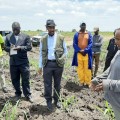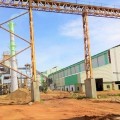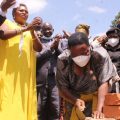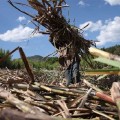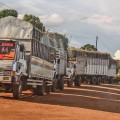MEDIA FOR CHANGE NETWORK
Why Atiak Sugar Project is not firing on all cylinders.
Published
3 years agoon
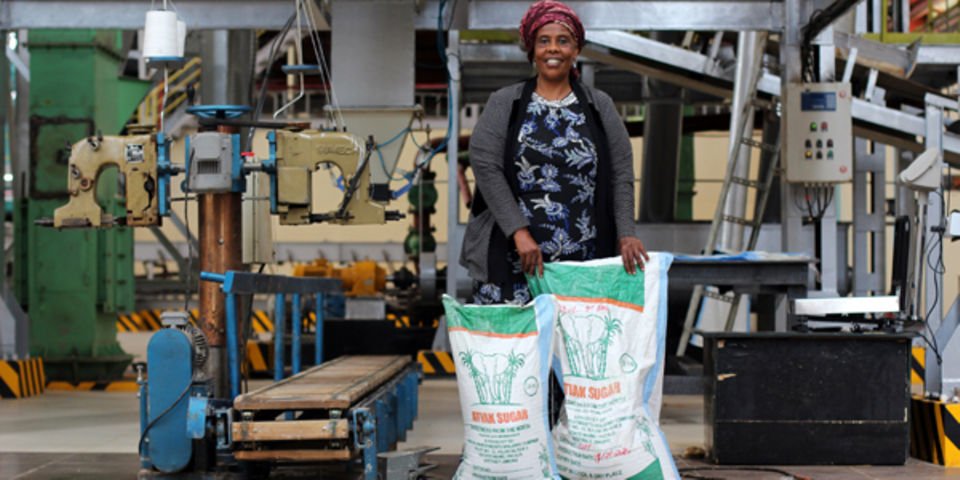
Ms Amina Hershi, the chief executive officer of Horyal Investment Ltd, displays some of the bags of sugar produced at Atyak Sugar Factory in Amuru District recently.
Atiak Sugar Limited is battling an acute shortage of sugarcane to supply the multi-billion sugar factory located in Atiak Sub-county, Amuru District. The vast bulk of its sugarcane plantations in both Amuru and Lamwo districts were ravaged by suspected arson attacks from alleged aggrieved members of two separate outgrowers societies.
The Atiak Sugar Project is still being spoken of in the present tense. It is essentially a public-private-community partnership between the National Agriculture Advisory Services (Naads), participating farmer cooperatives and respective local governments of Amuru, Lamwo and Horyal Investment Holdings Ltd.
The first bags of sugar from Horyal Investment Ltd’s multi-billion investment in the post-conflict north hit the streets of Gulu City once President Museveni commissioned the factory on October 22, 2020. The factory was initially meant to provide a ready market for the sugarcane outgrowers in the region where sugar production has already begun.
Under the partnership, the community under Atiak Outgrowers and Gem-pachilo Cooperative Societies are to plant cane on the land and weed the plantations. Once the cane is ready, the plantation—apportioned to the outgrowers by Naads—would be harvested and sold to the factory.
At its inception, the project targeted to cover 13,841 acres at the main plantation at Atiak in Amuru District. An expansion of 15,000 acres was, however, later made in Ayu-alali, Palabek Kal Sub-county, Lamwo District, in 2020. A further expansion of 31,159 acres is planned and is being established in Palabek-ogili, Lamwo District, bringing the total acreage to 60,000.
In September 2020, before its commissioning, Ms Amina Hershi, the chief executive officer of Horyal Investment Ltd, told a delegation of government officials that 3,000 acres of sugarcane were ready for supply to the factory to begin its maiden production. This section of the plantation belonged to Gem Pachilo and Atiak Outgrowers Cooperative Societies, she revealed, adding, “…we also now produce 6 MWh of electricity to the national grid, which is generated through biogas from the bi-products of the cane.”
At this point, the plant was, according to Ms Hershi, only waiting for calibration by the International Organisation for Standardisation to ensure the quality, safety, and efficiency of products, services, and systems.
Two years later, however, Saturday Monitor has learnt that simultaneous incidents of fire outbreaks that ravaged hundreds of hectares of the plantation appear to cast a dark shadow on the potential of the factory.
Outgrowers and the factory’s management accounts have indicated that since 2017, wildfires have gutted hundreds of hectares of the sugar plantation in the dry season. The burnt portions were usually canes that were nearing harvest or ready for harvest. We also understand that the portions burnt by the fire were always those owned by the outgrowers. These were not insured against fire, damages, or any other risks.
Late last month, the proprietors of the factory said sugar production had been suspended after cane supply to the factory hit rock bottom. According to the company, the suspension comes in the aftermath of wildfires that have in previous months destroyed the sugarcane plantation.
Mr Mahmood Abdi Ahmed, the company’s director for plantation and agriculture, told Saturday Monitor that production had drastically slowed down. He, however, hastened to add that operations haven’t been suspended as a result of the acute shortage of canes.
“The biggest challenge we have had is the gaps in our structural planning relating to the sugarcane production, and this failure is blamed on all of us the stakeholders,” Mr Mahmood said in an interview, adding, “The land (customary) ownership setup in the Acholi area has served a really big disadvantage to sugarcane growing because you don’t see people growing sugarcane on subsistence basis as we see in other regions producing sugar.”
According to him, in areas such as Busoga and Bunyoro sub-regions, “you find people growing sugarcane everywhere because the land is not communally owned and individuals decide on their own whether to grow sugarcane. But the communal ownership disfavours this, and this is one challenge we did not foresee.”
He also said the lack of associated amenities such as roads and urban trading centres where interested labour (workers) can reside has exacerbated things.
“The road infrastructure in communities here is still poor to boost sugarcane production,” he said, adding, “Even if communities grew these canes, the road networks are still underdeveloped to ease transportation of the canes.”
The company also lacks the infrastructure and human resources to deploy in sugarcane production. For example, Atiak Town Council or Elegu Town Council— the nearest trading centre—is 25km away from the factory, making transportation of the labour force over the distance a huge daily burden.
A fortnight ago, Ms Hersi told the media that the factory was temporarily suspending operations. According to her, the factory’s biggest problem was the lack of canes to supply the plant to produce sugar. She was, however, quick to add that the plantation would resume production once canes in Ayu-alali plantation in Palabek-kal Sub-county, Lamwo District, mature between July and August.
Sabotage galore
Ms Joyce Laker, the chairperson of Atiak Outgrowers Cooperative Society, however recently revealed that they were disappointed that Naads refused to pay their members.
During a public gathering at the factory, Ms Laker described the wildfires that swept across the plantations as deliberate sabotage. She also called for the government’s intervention after revealing that discontented cooperative members have openly threatened to continue burning down the sugar plantation until their grievances are settled.
“I will say it without shame…,” she stated. “…there are issues which the government has to come in and settle because at one point, in a meeting, some people said if these issues are not resolved, the sugarcane will continue getting burnt down.”
The longstanding dispute between the sugarcane outgrowers and the management of the sugar factory did not only delay the commencement of sugar production. Saturday Monitor also understands that the dispute has reportedly caused persistent and deliberate burning of the canes.
Ms Laker said the finger of blame can also be pointed elsewhere.
She referred specifically to the 2017 incident when Naads cut down more than 160 acres of sugarcane plantations belonging to Atiak Outgrowers and Gem-pachilo cooperative societies.
Saturday Monitor has established that the outgrowers are yet to be paid. We have also established that there are several instances of tension between the outgrowers, Horyal Investment Ltd and Naads over royalties and accumulated payments for canes cut and served to the factory.
Before President Museveni launched the factory in October 2020, the farm could not initialise sugar production for nearly eight months. This was due to the failure of the government to compensate two cooperatives for the sugarcane supplied to the factory.
Ms Grace Kwiyocwiny, the State Minister for Northern Uganda, told Saturday Monitor that roundtable talks between the leadership of the factory and the cooperative members are in the offing.
“We should protect all the little developments that are coming up in our region because all developments are supported by communities,” she said, adding, “I want to … come and meet with the leaders of the community because of the sugar [cane] that is continuously burning down.”
Earlier in March, when this newspaper visited the facility, the factory remained closed to production due to supply chain issues (shortage of cane). A perfect storm—including the pandemic, suspected arson attacks and insufficient production of canes by plantations in both Amuru and Lamwo districts—has contrived to create supply chain problems.
No respite from the east
In January 2021, Horyal Investment Ltd started sourcing its cane from the Busoga Sub-region. Sugarcane farmers in Busoga Sub-region, under the Greater Busoga Sugarcane Farmers’ Union (GBSGU), last month signed a memorandum of understanding with Atiak Sugar Factory to supply cane for six months. Under the arrangement, the government shall intervene by subsidising the transport costs and also avail fueled trucks to ferry the cane.
Inside sources have, however, told Saturday Monitor that the arrangement looks to have fallen flat on its face. The cost the investor incurred in transporting a truckload of canes is six times higher than what it paid for canes alone. A source who did not want to be named said while a truckload of canes fetched approximately Shs200,000, it costs between Shs800,000 to Shs1m to transport the consignment.
“They failed to sustain that arrangement because it was very expensive and the company realised it was sinking in losses to that effect; although the costs were being shared between the investor and Naads,” our source revealed.
Mr Michael Lakony, the Amuru District chairperson, fears that the suspension of the sugar production will destroy livelihoods in the sub-region.
“Hundreds of workers, including young men and women from the district here have been rendered jobless,” he told us in an interview, adding, “If the company wants to gain from the factory, it should get serious other than politicking.”
Mr Lakony added that because the government was allegedly not serious about streamlining the impasse and ensuring that Horyal Investments Ltd respects its terms in dealing with the outgrowers, the investor could continue grappling with suspicious fires.
“The plantations keep getting burnt because it is owned by no one and that means nobody cares, and if nobody cares, no one takes interest in taking care of it, including the neighbours because benefits in terms of payments to the out-growers are not being met,” he said.
Mechanisation drive
To address the challenge of labour deficiency and lack of funds to establish low-cost housing facilities in the factory to accommodate workers, Mr Mahmood said they are moving towards mechanising production.
“We don’t have the financing to build accommodation facilities to house thousands of workers who we would need to work on the plantation daily,” he told Saturday Monitor, adding, “Instead, we are strategising to focus on mechanising our production using the limited resources at our disposal now.”
He further revealed that they have procured a new fleet of sugarcane planters, weeders and harvesters due to arrive at the back-end of this year.
“The machines, we believe, are more efficient and can do much more work compared to human labour and that will solve the puzzle,” he noted.
Although Mr Mahmood did not disclose the source of the funding, in a separate interview, Mr Lakony—the Amuru LC5 chairperson—said the company had been granted a Shs108 billion bailout by the government for mechanising production.
“We had a meeting with the management as a district and also shareholders and the latest update is that the government has allocated Shs108 billion to the company through UDC [Uganda Development Corporation],” Mr Lakony said, adding, “The plan is to leave rudimental and turn to mechanised production. Instead of using human labour, they want to use machines.”
A fraction of the same funds will also be used to establish an irrigation system on River Unyama that cuts through the sugar plantation to help in irrigating the canes during the dry season when immature and young canes dry and die out, Mr Lakony added.
Saturday Monitor understands the Shs108 billion is the same funding thrown out by Parliament’s Budget Committee last November. This was after the investor made a supplementary budget request to finance production. The request tabled by junior Trade minister David Bahati, and backed by the UDC’s top brass, failed to convince the lawmakers, who in turn sent them away.
The MPs declined to endorse Ms Hersi’s request to the government, reasoning that there was a need for proof that her investment was making a substantial contribution to the economy. The MPs instead demanded a forensic audit into how she has spent more than Shs120 billion received from the government. Similar financial requests were made by the Atiak Sugar leadership to the 10th Parliament, but most of them were rejected, although it later emerged that they were, nevertheless, granted.
Some of the fire incidents at Atiak Sugar project
In 2016, a fire caused an estimated loss of Shs150m after it gutted 150 acres of sugarcane plantation at the factory.
In December 2018, another mysterious fire destroyed an estimated 250 acres of sugarcane at the facility.
An estimated 600 acres of sugarcane at the plantation was then burnt down in February 2019.
And in January 2021, a fire that lasted for nearly a week destroyed nearly 60 percent of the plantation after the police fire brigade fought it with little success.
Eventually, more than 600 acres of sugarcane estimated at Shs3 billion were reported to have been destroyed in the fire.
In fact, that fire in January of 2021 was the worst to ever hit the plantation. The police attributed the rapid spread of the fire to narrow fire lines that do not allow fire trucks to move in fast.
Enter January of 2022, a similar fire burnt down an estimated 3,500 acres of the sugarcane plantation.
According to Mr David Ongom Mudong, the Aswa River Region police spokesperson, the fire razed down 14 huts belonging to a Uganda People’s Defence Forces (UPDF) detachment. The soldiers, who were supposed to stand as sentinels at the plantation, watched helplessly as 250 acres were burnt down.
Background
About the factory
Atiak Sugar Factory, located at Gem Village in Pachilo Parish in Atiak Sub-county in Amuru District, is jointly owned by the Uganda and Horyal Investment Holdings Company Ltd. The latter belongs to Ms Hersi.
The factory—located 17kms north of Atiak off the Gulu-Nimule Road—is the first major investment in the region.
Lawmakers have, however, continued to question why the government’s stakes in it have remained significantly low compared to that of Horyal Investments despite the huge capital portfolio injected in the past years into the venture.
Last September, Parliament’s Committee on Trade questioned why the government—the lowest shareholder in Atiak Sugar Limited—continues to invest the most money in the factory.
The government’s shareholding in the plant has remained static at 40 percent despite an injection of more than Shs120 billion.
In May 2018, when the government injected Shs20 billion, its shareholding stood at 10 percent. In the same year, it injected another Shs45 billion—raising its shares to 32 percent.
The committee also questioned the circumstances under which Naads contracted the company to clear, plant, and harvest sugar cane valued at Shs54 billion instead of working directly with the outgrowers.
Source: Daily Monitor
You may like
MEDIA FOR CHANGE NETWORK
Bridging the access to justice gap: Witness Radio trains paralegals ahead of Uganda’s general election.
Published
6 days agoon
May 29, 2025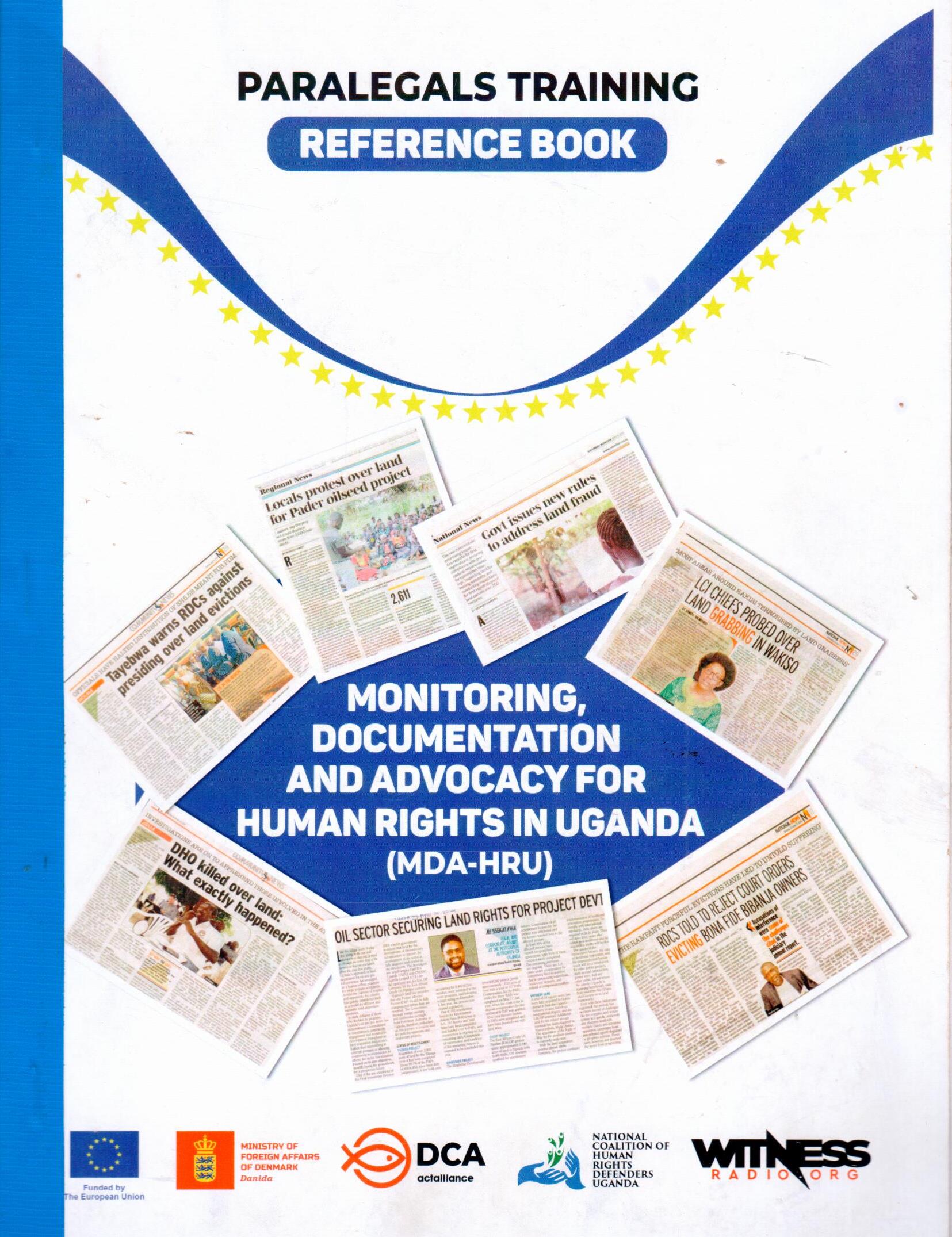
By Witness Radio team.
Kiryandongo, Uganda—Communities across Uganda are currently in the midst of a pressing and severe crisis due to the impacts of land-based investments. These include forced evictions, lack of consultation, and concealed project information. These injustices persist due to a widespread lack of legal awareness and limited access to justice among affected communities.
As Uganda enters the general election period, more farming communities’ land will continue to be forcibly taken from them by multinationals and individual investors, and the number of community land rights and environmental defenders will likely increase. This is because citizen’s liberty is at stake during electoral periods and all justice institutions quite often prioritize electoral justice during this period. Besides, perpetrators of forceful land evictions may use merits of electoral violence to criminalize land and environmental rights defenders in order to silence their activism. Community land rights and environmental defenders work to protect the rights of communities to their land and natural resources. Witness Radio has documented and provided legal representation to dozens of them whose work has been criminalized by wealthy individuals and multinationals.
“We are often evicted from our land without prior consultation, compensation, or meaningful resettlement,” said Benon Beryaija, a community representative from Kiryandongo district. “The evictors tell us they have ultimate power over our land and that we have no right to resist. These evictions happen without following the law.”
Beryaija is among the thousands of people in Kiryandongo whose land was grabbed by a group of multinationals without compensation or resettlement. According to Witness Radio, Agilis Partners Limited is among the multinational companies alongside Kiryandongo Sugar Limited and Great Seasons SMC Limited that have forcibly displaced over 35,000 people to pave the way for large-scale agricultural operations since 2017.
“But all this violence continues because we are ignorant about the law,” Beryaija added. “We don’t know what to do, what to ask for, or how to demand accountability. The companies use this gap to take advantage.”
To address this critical gap in legal knowledge, Witness Radio Uganda, in collaboration with the European Union, Dan Church Aid (DCA), and the National Coalition for Human Rights Defenders in Uganda (NCHRD-U), conducted the first-ever paralegal training for selected community activists against irresponsible Land-Based Investments (LBIs) and Land and Environmental Defenders (LEDs) in the Midwestern Subregion of Uganda. This initiative aims to equip grassroots defenders with basic legal tools to resist human rights violations and abuses as well as land injustices and environmental destruction and to advocate for their communities, instilling a sense of empowerment and hope.
“Community defenders are at the forefront of the fight for land rights and environmental justice and should provide that first-hand legal support, but they often lack the tools to engage with legal systems or resolve disputes effectively. We are currently emphasizing the importance of equipping communities with legal knowledge on land and environmental rights, a clear understanding of what to do when a defender is arbitrarily arrested and detained or disappears, what to do when an investor comes to communities’ land, how to effectively to document human rights violations/abuse, and practical ways to speak to power and hold perpetrators to account for their deeds,” said Mrs. Bulyerali Joan, Witness Radio’s Head of Community Empowerment.
The three-day training, held last week from May 19th to 21st in Uganda’s mid-western region, brought together 20 participants from eviction-prone districts, including Kiryandongo, Hoima, Masindi, Kibale, Kagadi, and Buliisa. This training, which covered key topics, was a significant step in the fight against land evictions, as highlighted in a 2024 Witness Radio report on land evictions. The report, based on extensive research and interviews with affected communities, revealed the alarming rate of land evictions and the urgent need for legal empowerment among these communities.
The training covered key topics, including understanding the criminal justice system and how it operates, how to represent others and oneself in interactions with the police or in court, understanding land and environmental rights, documenting violations, legal processes for seeking redress, community mediation techniques, and how to demand accountability from perpetrators.
“Our goal is to empower them with the legal knowledge necessary to act as first responders in their communities, especially during this upcoming general election, to stop arbitrary arrests and detention, empower communities to push back illegal land evictions, and guide others even without the immediate presence of lawyers or our organization.” Ms. Buryelari added, underlining the crucial role of the paralegals in the upcoming elections.
Oyungi Jovia, one of the Land and Environmental Defenders (LEDs) who participated in the training, described it as impactful and an eye-opener, particularly in addressing pressing community concerns and understanding their role in mitigating harm. The training has not only equipped her with the necessary legal knowledge but also boosted her confidence in supporting those who seek her help.
“We didn’t know the legal processes to follow. Now we know where to start, what documents are required, and how to collect and present evidence in land-related cases,” she shared. “I have learned how to guide community members in legal matters, and now more confident in my ability to support those who come to me for help.”
Before the training, Jovia admitted that she and others often struggled to respond to community concerns due to their limited understanding of the law. “People would come to us for advice, but we barely knew what to tell them. This training has changed everything.” She added.
As land-based conflicts continue to rise in Uganda, particularly in regions targeted by large-scale agribusiness projects, Witness Radio’s paralegal initiative represents a significant step toward community-led access to justice and legal empowerment.
“We are building a network of informed grassroots leaders,” Mrs. Bulyerali emphasized, “who can defend their peers, community land rights, document violations, and help others seek justice, even in the absence of Witness Radio.”
Related posts:

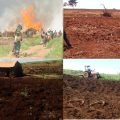 Witness Radio, private companies, CSOs and local government officials are meeting to discuss alternative remedies to salvage the appalling land and environmental rights situation in Kiryandongo district.
Witness Radio, private companies, CSOs and local government officials are meeting to discuss alternative remedies to salvage the appalling land and environmental rights situation in Kiryandongo district.
 Witness Radio Uganda wins the best CSO land rights defenders award at the National Land Forum Awards.
Witness Radio Uganda wins the best CSO land rights defenders award at the National Land Forum Awards.
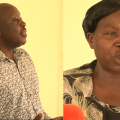 Kiryandongo leadership agree to partner with Witness Radio Uganda to end rampant forced land evictions in the district.
Kiryandongo leadership agree to partner with Witness Radio Uganda to end rampant forced land evictions in the district.
 Local communities lost over 60,000 acres of land to grabbers at a time Witness Radio – Uganda was under a suspension.
Local communities lost over 60,000 acres of land to grabbers at a time Witness Radio – Uganda was under a suspension.
MEDIA FOR CHANGE NETWORK
Ugandan Communities Say Total’s Oil Project Is More of a Land Grab than a Development Opportunity
Published
6 days agoon
May 29, 2025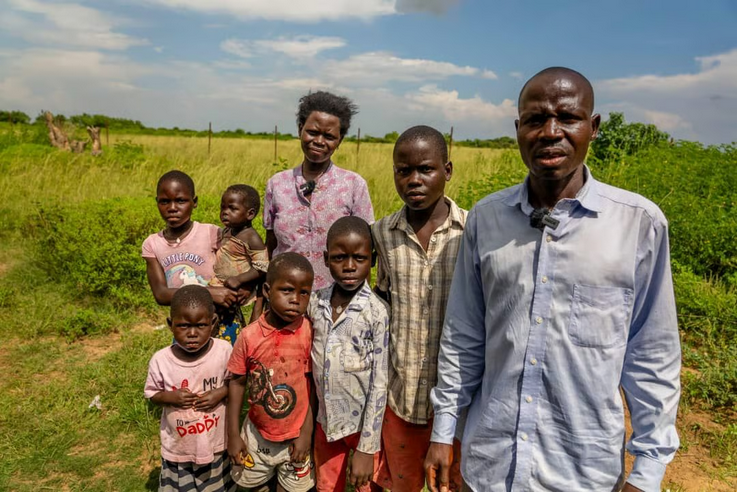
Fred Balikenda and his family were forcefully evicted from their home in Kirama village, Buliisa district on May 13, 2024 to make way for the Tilenga project. Photo by Diana Taremwa-Karakire.
When Jealousy Mugisa Mulimba, a 52-year-old father of nine in Uganda’s oil-rich Buliisa district, was informed he would need to move his family from his ancestral home because French oil giant TotalEnergies needed his three acres to build their central processing facility in the region, he was reasonable. He didn’t put up a fight. Instead, he asked that the company give him three acres nearby; somewhere out of the way of the facility, but still near the place he’d always called home, the health facilities he and his family rely upon, and his kids’ schools.
He was instead shown land far away, isolated and distant from everything and everyone he’d ever known. After a five-year legal battle, a Ugandan court expropriated his land anyway in 2023, along with that of 41 other affected people.
“They are inhuman,” he said during a recent interview. “This is my land on which my ancestors are buried. I will not just leave like they want, I will continue fighting.”
Together with other affected people, Mr. Mulimba plans to appeal the decision of the Hoima court in Uganda’s high court.

A resettlement house built by TotalEnergies for project affected persons PAPS . Some PAPs have expressed concerns that these houses are isolated compared to the communal settings they were accustomed to. Photo by Diana Taremwa-Karakire.
Although the Ugandan government promises that oil projects will lift the country out of poverty and put Uganda’s natural resources to work for the betterment of Ugandan citizens, activists are concerned not only about the hundreds of millions of tons of carbon dioxide these projects will generate, but also about the more immediate impacts. These range from the potential for spills and the impact on animals and birds in biodiverse regions, to the way the country’s burgeoning fossil fuel industry is displacing various communities, bringing them not the promised riches of an oil boom, but sending them ever deeper into poverty.
Uganda first discovered commercial quantities of oil nearly 20 years ago, but it wasn’t until TotalEnergies and the Chinese National Offshore Oil Company CNOOC inked a deal to exploit the resources in the Lake Albert region in 2022 that the country’s fossil fuel industry began in earnest. The region, which lies on the country’s western border with the Democratic Republic of the Congo, is estimated to hold over 6.5 billion barrels of oil, with 1.4 billion barrels economically recoverable. TotalEnergies is the major operator for both the Tilenga oilfields, a $6 billion project covering Buliisa and Nwoya districts near the shores of Lake Albert, and the East African Crude Oil Pipeline, or EACOP, project that will transport that oil from Uganda to an export port in Tanzania. Other partners are CNOOC and the state-owned Uganda National Oil Company, as well as Tanzania’s state-owned Tanzania Petroleum Development Corporation.
Getting all that oil and gas to customers requires infrastructure, which is where EACOP comes in. The plan calls for a 900-mile pipeline stretching from the small town of Kabale, in western Uganda, to the Tanzanian port of Tanga. If completed, it will have the capacity to carry up to 246,000 barrels of crude a day to a storage terminal and loading jetty in Tanga. The waxy nature of Uganda’s crude will require the pipeline to be heated constantly for the crude to keep flowing. Experts say that this is the largest heated oil pipeline to be constructed.
Meanwhile, the Tilenga oilfields lie in one of not just Uganda’s but Africa’s most biodiverse regions. According to state environment regulator National Environment Management Authority NEMA, the Albertine region hosts 14 percent of all of African reptiles, 19 percent of Africa’s amphibians and 52 percent of the continent’s birds, as well as 35 percent of all of Africa’s butterflies and 39 percent of all African mammals.
The project includes the development of 6 oil fields and the drilling of about 426 wells, with 10 wellpads located inside Murchison Falls National Park, Uganda’s largest national park. It also includes an industrial area with a lake water abstraction facility and a central processing facility capable of processing up to 200,000 barrels of oil per day. Currently, the project aims to produce up to 190,000 barrels of oil daily to meet global demand. Drilling activities are ongoing at Tilenga with over 110 wells drilled so far.
Land Grab
The completion of the Tilenga and EACOP projects will not only displace animals, birds and amphibians, but also people. The projects require a land acquisition program covering some 6,400 hectares. This means relocating 775 primary residences, and affecting a total of 19,262 stakeholders, landowners, and land users.
TotalEnergies is responsible for overseeing the land acquisition process, including all administrative costs and compensation payments. However, the company contracted Atacama Consulting, a Ugandan firm, to carry out the implementation of this process.
While land and property rights in Uganda are safeguarded under Article 26 of the Constitution and the Land Act of 1998, the land acquisition process for these projects is guided by government-mandated Land Acquisition Resettlement Framework and Resettlement Action Plans (RAPS) that are part of assessments carried out by TotalEnergies. The compensation rates for land, permanent buildings, rates for crops and temporary structures are determined based on market analysis approved by the chief government valuer.
The Tilenga RAP stipulates that the project will re-establish the livelihoods of affected persons to an equal or greater level than before the project activities. Most of the land has been acquired from the 5,576 landowners or project affected people under the Tilenga project.
However, many of the people in question, like Mulimba, report unresolved disputes and claim that these projects have left them worse off than before, driving them deeper into poverty.
On December 8, 2023, the High Court in Hoima ruled that 42 households be evicted before compensation to make way for the Tilenga Project. The court allowed TotalEnergies to deposit compensation funds in court and take the land, even by force if needed. While the company made compensation payments after resolving disputes, many affected families still argue that the compensation was inadequate.
The Ugandan project, along with the vast natural gas fields of Mozambique, are at the center of TotalEnergies’s Africa strategy, which it says is to “develop responsible, low cost, low emission oil and gas production.” This strategy fits well into the plans of Uganda’s long-time leader, Yoweri Museveni, who has made the development of the $10 billion hydrocarbon industry a cornerstone of his plan to transform this impoverished East African nation.
At an event to announce the final investment decision for the $10bn project in February 2022, TotalEnergies chief executive Patrick Pouyanné said that he had travelled to Uganda more than any other country since 2018 to push through the project.
“The development of Lake Albert resources is a major project for Uganda and Tanzania, and our ambition is to make it an exemplary project in terms of shared prosperity and sustainable development. We are fully aware of the important social and environmental challenges it represents,” he said.
But allegations of rights violations to local communities have dogged the oil giant. Activists say the Tilenga project’s land acquisition process has been marked by delayed, inadequate and unfair compensation as well as the use of threats, intimidation, and other tactics to coerce many poor families into accepting bad deals for their land. This has led to resistance to the project’s efforts to fence off land in some areas, despite the company’s insistence that it sought consent and is following social safeguards.
“TotalEnergies has failed to respect the rights of local communities. It has failed to gain the informed consent of affected communities for the project as is legally required,” said Benon Tusingwire, the executive director at Navigators of Development Association NAVODA, a local rights group working in the project area. He also noted that officials from Atacama have been coercing and tricking affected people into signing consent forms for the acquisition of their land.
TotalEnergies did not reply to multiple requests for comment.
As the deadline for the production of first oil approaches, the actions of both TotalEnergies and government officials have become more aggressive, residents claim.
On the morning of May 13, 2024, Fred Balikenda (pictured in the photo at the top of this story), a local peasant farmer living on the margins of one of TotalEnergies oil wells, suffered one of the most brutal evictions to date. A group of gun-toting policemen in Toyota Pickup trucks bumped into the fenced enclosure of Balikenda’s home and ordered him and his wife out of their 4 bedroom house. As they waited in the yard, the officers, backed by around a dozen un-uniformed men, started demolishing the house.
Balikenda, along with other landowners, including Mulimba, lost the suit in April 2024 in which they had sought to halt their evictions. The Judge in Hoima city, near the oil fields, ruled that money meant for the expropriation compensation should be deposited with the court and that the government could evict locals so that TotalEnergies construction activities could go ahead.
“They threw out some of my belongings through the windows,” Balikenda said, gazing into the distance. “We are now living a life of destitution, we have lost so much land to the project and yet what we were being compensated isn’t equal to what is being taken. We no longer have access to community grazing land, all my cows and pigs have died.”
Even before this eviction, Balikenda was effectively living in an open-air prison for months after TotalEnergies fenced in his home and a 1-acre piece of land that he had refused to vacate before his replacement house was complete. His pigs starved to death because he could no longer get out of the enclosure to get them fodder, he says. Court is yet to rule on their appeal.
“We are really going through some of the roughest times,” Balikenda said. “Our families are traumatized”
The Petroleum Authority of Uganda, or PAU, the state regulator for the oil and gas sector, says that recent evictions of Tilenga affected persons followed the due legal process.
“The Tilenga Project prioritizes minimizing disruption to affected communities and ensuring that all PAPs [project-affected persons] are adequately compensate for their losses and inconveniences. Despite the comprehensive compensation and resettlement efforts, the final PAPs’ repeated refusal to relocate necessitated legal action by the government,” says a statement from PAU.
However, lawyers representing Balikenda and others insist that the court process was flawed. In a country where the justice system mostly rules in favor of the government, affected people remain helpless.
“If it were not for the harassment, intimidation, arrests, detentions and other threats that they face, they would never have accepted the low compensation,” said Tusingwire.

Pump Station 1 (PS1) of the East African Crude Oil Pipeline project in Hoima district, a critical part of the EACOP infrastructure, receiving crude oil from feeder pipelines from the Kingfisher and Tilenga oil fields and transporting it to port Tanga in Tanzania. Photo by Diana Taremwa-Karakire.
The Pattern Continues in Mozambique
More than 2000 kilometers to the south, TotalEnergies’ $20 billion natural gas project in northern Mozambique’s Cabo Delgado province was saved in 2021 by a well-timed donation from France to Rwanda, which was followed just a few weeks later by the deployment of some 2,500 Rwandan peace-keeping troops to fight Jihadist fighters in the region. The deployment happened months after TotalEnergies had declared force majeure on the project due to an offensive by Islamic State-linked insurgents.
The insurgency, which has been raging since 2017, is mainly spearheaded by angry young men who resent security force abuses and believe elites monopolize the region’s natural resources while local communities starve. As in Uganda, the company’s approach to land acquisition and community outreach has not served to quell that anger; relocation efforts have often resulted in the displacement of communities far from their traditional and familial roots, with farmers being moved to non-arable land or fishermen to new villages far from the sea.
Critics of the gas project argue that while the insurgency is rooted in Cabo Delgado’s complex political and religious history, so far Total’s operations follow a familiar pattern of extracting wealth from the province with little benefit to local residents.
According to the International Crisis Group, the insurgents are fighting for a “meaningful role in the Cabo Delgado economy, so they can benefit from the opportunities created by major mining and gas projects.”
TotalEnergies has been forced to shore up more security measures, signing a security pact contracting Isco Segurança, a security company backed by Rwanda’s ruling party, to secure the gas fields. But analysts believe that such security arrangements will not leave a lasting solution since the grievances are felt deeply by large sections of the region’s impoverished population.
“Thousands of Livelihoods Devastated”
A 2023 report by Human Rights Watch indicated that the EACOP project has devastated thousands of livelihoods in Uganda and risks locking in decades of greenhouse gas emissions, contributing to the global climate crisis. More than a dozen banks and insurance companies have shunned investment in EACOP, citing environmental and human-rights concerns.
With so many lenders on the sidelines, China has been willing to show support for the project. Last year, Ruth Nankabirwa, the Minister of Energy and Mineral Development, told state media that China would provide more than half of the $3.05 billion in debt financing needed, with smaller lenders taking up the rest of the slack.
According to the government, the oil industry is projected to bring a $40 billion boost to Uganda’s economy. When production is at its peak, the government will receive an anticipated $2 billion a year in revenue from the development.
Irene Batebe the permanent secretary at the Ministry of Energy and Mineral Development says that the government is committed to ensuring that the oil and gas sector is exploited without breaching environmental guidelines. Commercializing Uganda’s oil and gas will provide funds to spur development and investment in more renewable energy sources. The industry will also produce Liquified Petroleum Gas, which Batebe says will provide a cleaner cooking energy source and help to save crucial forest cover.Uganda is set to produce 100,000kg of liquified petroleum gas annually at the peak of oil production which is set to be used for cooking in homes, transport and heating.
From 2001 to 2023, Uganda lost 1.10 Mha of tree cover, equivalent to a 14% decrease in tree cover since 2000 according to figures from Global Forest Watch.
Forest cover has been shrinking at a rate of 15 percent each year over the past decade, due largely to the country’s over-reliance on charcoal and firewood for cooking.
“The real problem is not EACOP or fossil fuels , the real problem is, you have at least 57%of households having access to a source of electricity meaning the bulk of us are depending on rudimentary biomass,about 80% of our population is burning fuel wood and charcoal,” Batebe says.
But not everyone agrees on what constitutes “betterment” and for which people. In an interview, Dickens Kamugisha, the Chief Executive Officer of Africa Institute for Energy Governance, contends that the Ugandan government appears bent on maximizing proceeds from the industry without regard for Indigenous communities and the environment.
“The longer we wait to reduce emissions, the greater our collective suffering will be,” said Mr. Kamugisha , who spent weeks in detention in 2021 over charges related to his environmental advocacy work around EACOP “We must reduce and eventually eliminate our dependence on fossil fuels if we are serious about halting global warming.”
Source: drilled.media
Related posts:

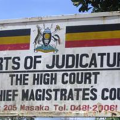 EACOP: Another community of 80 households has lost its land to the government and Total Energies to construct an oil pipeline.
EACOP: Another community of 80 households has lost its land to the government and Total Energies to construct an oil pipeline.
 Former Benin PM to assess oil land compensation in Uganda
Former Benin PM to assess oil land compensation in Uganda
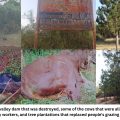 Profiting from misery: A case of a multimillion-dollar tree project sold off before resolving land grab and human rights violation claims with local communities.
Profiting from misery: A case of a multimillion-dollar tree project sold off before resolving land grab and human rights violation claims with local communities.
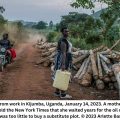 “Our Trust is Broken”: Oil Pipeline Project Impoverishes Thousands
“Our Trust is Broken”: Oil Pipeline Project Impoverishes Thousands
MEDIA FOR CHANGE NETWORK
A decade of bloodshed: 1,088 Human Rights defenders killed for resisting corporate abuse
Published
7 days agoon
May 28, 2025
A crowd gathers at a vigil for human rights defenders Antonio Díaz Valencia and Ricardo Arturo Lagunes Gasca, who were forcibly disappeared on January 15, 2023, in Mexico. Photo Credit: Gustavo Vilchis.
By Witness Radio team.
Challenging corporate harm caused by business-related activities is a ticking time bomb, as many who dared to speak out have been silenced forever. Yet, their courage in the face of such danger is a testament to their unwavering commitment to justice.
In the last ten years, close to 1,100 human rights defenders across the globe have been murdered for speaking up against destructive corporate practices. This is not a localized issue but a global crisis that demands our attention and action.
These staggering statistics are captured in a new report titled “Defending Rights and Realising Just Economies: Human Rights Defenders and Business (2015–2024)”, published by the Business and Human Rights Resource Centre. The report paints a disturbing picture, with over 6,400 attacks on human rights defenders (HRDs) documented worldwide since 2015, and among those, 1,088 were fatal.
On average, that means every year, more than 100 people are killed simply for defending their land, water, forests, or the rights of their communities.
“Human rights defenders are on the frontlines of justice – challenging abuse, protecting our planet, and envisioning a better future for us all. Yet they continue to face relentless and often deadly retaliation simply for their defense of human rights. Said Christen Dobson, Co-Head of the Civic Freedoms and Human Rights Defenders Programme at the Business & Human Rights Resource Centre.
Most of the violence targets defenders confronting the fossil fuel, mining, and agribusiness industries — sectors notorious for land grabs and environmental degradation.
According to the report, nearly one-third of those killed were Indigenous defenders deeply connected to their land and culture. Latin America remains the deadliest region, followed closely by the Philippines, among others.
While governments have a duty to investigate these murders, the report says the majority of attacks – both lethal and non-lethal – go uninvestigated and unpunished, fostering a culture of impunity that only strengthens further violence.
“We commemorate the lives, courage, and vital work of these HRDs and their communities. While governments have a duty to investigate these murders, the majority of attacks, both lethal and non-lethal, go uninvestigated and unpunished, fostering a culture of impunity that only emboldens further violence,” the report revealed
Beyond killings, the report also details countless cases of threats, criminal charges, surveillance, and smear campaigns used to discredit and break down defenders. It demonstrates how legal systems are being increasingly weaponized to silence dissent further.
In 2024 alone, 89% of the HRDs attacked were land and environmental defenders. In addition, 96% of local community defenders experiencing attacks over the past decade were advocating for land and environmental rights, highlighting their leadership in protecting natural resources and the planet.
Some of the projects linked to the highest number of attacks over the last ten years include the Lake Albert oil extraction and development project (which consists of the East African Crude Oil Pipeline) (Uganda and Tanzania), Inversiones los Pinares (Honduras), Dakota Access Pipeline (USA), Las Bambas Mine (Peru) and Line 3 Pipeline (USA and Canada).
Many governments have aligned with the perpetrators by weaponizing legal systems to attack HRDs, setting a path for private actors to follow suit, thereby neglecting their core responsibility of protecting human rights.
The report also puts a spotlight on Uganda, where defenders resisting oil development in the Albertine region have faced an intense wave of repression. In particular, it highlights attacks related to the Lake Albert oil extraction and development projects, which include the East African Crude Oil Pipeline (EACOP). This project, operated by a consortium of powerful actors, has been a source of conflict and human rights abuses in the region.
These projects are operated by a consortium of powerful actors: TotalEnergies, which owns the majority stake and operates the Tilenga project; the China National Offshore Oil Company (CNOOC), which runs the Kingfisher project; and the Uganda National Oil Company.
But while the Ugandan government promotes these developments as a path to economic transformation, local communities tell a different story — one of forced evictions, sexual and gender-based violence, loss of farmland, polluted water sources, and shattered livelihoods.
According to the report, at least 102 attacks have been recorded against Ugandan defenders who have spoken out against these oil projects. These include cases of judicial harassment, arrests, and threats, among others.
The report concludes with a call to action: for governments to fulfill their duty to protect human rights defenders by investigating and prosecuting attacks against them; for corporations to respect human rights by conducting their business in a way that does not infringe on human rights; and for global solidarity to rise in defense of those who risk everything for justice, by supporting and advocating for the rights of human rights defenders.
Related posts:
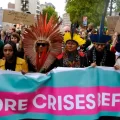
 EU stands behind the empowerment of Human Rights Defenders
EU stands behind the empowerment of Human Rights Defenders
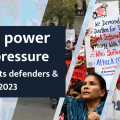 Breaking: Over 600 attacks against defenders have been recorded in the year 2023 globally- BHRRC report.
Breaking: Over 600 attacks against defenders have been recorded in the year 2023 globally- BHRRC report.
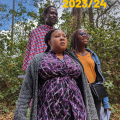 Attacks fueled by governments’ double standards fail to deter human rights defenders
Attacks fueled by governments’ double standards fail to deter human rights defenders
 Human Rights Defenders not safe in Uganda – Unwanted Witness report
Human Rights Defenders not safe in Uganda – Unwanted Witness report

Bridging the access to justice gap: Witness Radio trains paralegals ahead of Uganda’s general election.

Ugandan Communities Say Total’s Oil Project Is More of a Land Grab than a Development Opportunity

A decade of bloodshed: 1,088 Human Rights defenders killed for resisting corporate abuse
World Bank-Funded TANAPA Rangers Murder Two Villagers in Ruaha National Park

EACOP project triggers floods in Kyotera District.

Ugandan activist asks HSBC to put ‘lives before profit’ as campaigners target bank’s AGM

Bridging the access to justice gap: Witness Radio trains paralegals ahead of Uganda’s general election.

A decade of bloodshed: 1,088 Human Rights defenders killed for resisting corporate abuse

Innovative Finance from Canada projects positive impact on local communities.
Over 5000 Indigenous Communities evicted in Kiryandongo District
Petition To Land Inquiry Commission Over Human Rights In Kiryandongo District
Invisible victims of Uganda Land Grabs
Resource Center
- LAND GRABS AT GUNPOINT REPORT IN KIRYANDONGO DISTRICT
- RESEARCH BRIEF -TOURISM POTENTIAL OF GREATER MASAKA -MARCH 2025
- The Mouila Declaration of the Informal Alliance against the Expansion of Industrial Monocultures
- FORCED LAND EVICTIONS IN UGANDA TRENDS RIGHTS OF DEFENDERS IMPACT AND CALL FOR ACTION
- 12 KEY DEMANDS FROM CSOS TO WORLD LEADERS AT THE OPENING OF COP16 IN SAUDI ARABIA
- PRESENDIANTIAL DIRECTIVE BANNING ALL LAND EVICTIONS IN UGANDA
- FROM LAND GRABBERS TO CARBON COWBOYS A NEW SCRAMBLE FOR COMMUNITY LANDS TAKES OFF
- African Faith Leaders Demand Reparations From The Gates Foundation.
Legal Framework
READ BY CATEGORY
Newsletter
Trending
-

 MEDIA FOR CHANGE NETWORK6 days ago
MEDIA FOR CHANGE NETWORK6 days agoBridging the access to justice gap: Witness Radio trains paralegals ahead of Uganda’s general election.
-

 MEDIA FOR CHANGE NETWORK7 days ago
MEDIA FOR CHANGE NETWORK7 days agoA decade of bloodshed: 1,088 Human Rights defenders killed for resisting corporate abuse
-
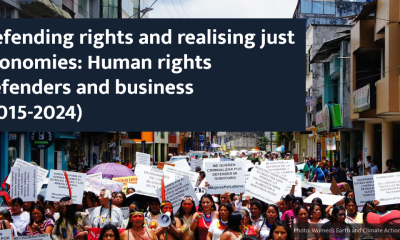
 NGO WORK2 weeks ago
NGO WORK2 weeks agoDefending rights and realising just economies: Human rights defenders and business (2015-2024)
-

 NGO WORK2 weeks ago
NGO WORK2 weeks agoIndonesia: 46 companies linked to allegations of human rights and environmental abuses associated with 2nd largest palm oil producer; incl. cos. responses and non-responses
-
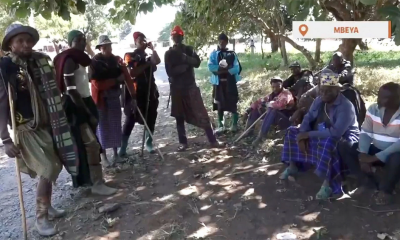
 NGO WORK2 weeks ago
NGO WORK2 weeks agoWorld Bank-Funded TANAPA Rangers Murder Two Villagers in Ruaha National Park
-
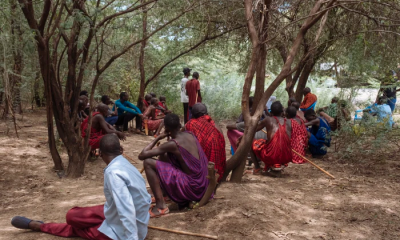
 MEDIA FOR CHANGE NETWORK2 weeks ago
MEDIA FOR CHANGE NETWORK2 weeks agoKenya: Court suspends Netflix and Meta’s carbon credits project over land dispute with Maasai herders
-

 MEDIA FOR CHANGE NETWORK6 days ago
MEDIA FOR CHANGE NETWORK6 days agoUgandan Communities Say Total’s Oil Project Is More of a Land Grab than a Development Opportunity

